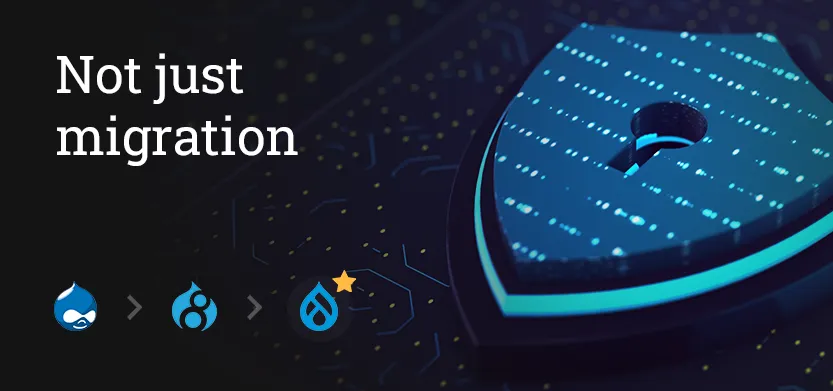

Posted in Drupal
May 12, 2023
Drupal 7 to Drupal 9: More Than a Migration
With Drupal 7’s end-of-life date fast approaching (November 23, 2023), it’s time to discuss making a change. But since Drupal 8 is now unsupported, you will need to jump to Drupal 9.
If you’ve already been looking into changing from Drupal 7 to Drupal 9, you’ve probably seen ads or content using language like “migrate today” or “Drupal migration services.”
I personally think that language is a bit misleading, and it sells the complexity of the change in platforms short.
Going from Drupal 7 to Drupal 9 is a platform upgrade. Drupal 8 to Drupal 9 is also an upgrade and the easiest major upgrade in a decade, according to our dear friend Josh Miller.
So, why am I even bringing up the language difference between migration and upgrade? It is not just semantics, I assure you. Understanding the differences will help organizations realize why an upgrade is more than a migration.
What is migration?
The common use of the word migration is fairly broad. It can mean a platform upgrade or moving a process from one system to another. And then there is the seasonal bird travel.
When a sales or operations manager says to their team, “we need to migrate away from XYZ to ABC,” I can hear the developers and IT team grind their teeth. That manager is saying they need to move off one platform and onto another (aka replatforming). That, my friends, is NOT a migration.
In layman’s terms, migration is simply the transfer of data. It requires information to be exported from one platform, matched up to the corresponding fields in the new platform and then moved over. It is a critical step in the upgrade process, but not the only one, and it may not even be as straightforward as one would think. Shawn and Steve have a great High Five episode on data migration. Check it out here.
What is an upgrade, then?
An upgrade, even when it is the same platform, is when you are moving your data to a setup with new features, substantial changes to existing features and other significant improvements. It also means that some of the functionality on your old platform may not exist on the new system. You will need to adjust workflows or processes to account for those changes.
The difference in features and functionality is what we call parity, and can be a big stumbling block for system users, so let’s dive into parity a little bit.
What is feature or function parity?
Let’s consider a platform upgrade like moving from a 1980 Ford F-150 to a 2022 model. It’s still a pickup truck. It still has an engine, doors, wheel, brakes, and seatbelts, and it still gets you from point A to point B. But, there are features and functionality in the 2022 model that the 1980 model certainly does not have. Some of these changes improve safety, others improve performance. But some functions are missing.
In the 2022 model, there are no cigarette lighters (they have been converted to AC power plugs), no ashtrays, and no cassette players. The upgrade has removed outdated or deprecated functionality. In most cases, these are replaced by improved functions.
The functions that have been improved, though, have new features. Most of the changes in the upgrade are simple to use, but if you are still trying to play your Dad’s old Travis Tritt tape, that may pose a problem. The upside is that now when you apply the brakes, you will stop a lot sooner.
Why is an upgrade more than a migration?
In the context of Drupal 7 to Drupal 9, you are looking at a replatforming project with multiple steps. As mentioned previously, data migration is only one of those steps.
Replatforming is not an exercise in recreating your old platform's features in your new one. A successful upgrade focuses on
- Evaluating the state of your current platform, systems and infrastructure.
- Porting, improving or ditching features before moving them to the new platform.
- Continually assess and improve the functionality and performance of your new system.
A desire to move each feature “as-is” to the new platform is the most common failure point in most replatforming projects. It is also the biggest point of contention between users of the new platform. Learn how to avoid replatforming project failure with our ebook, The Development Foundations of Replatforming.
Replatforming is also a chance to talk with your teams about what other improvements they need or want from their systems. Replatforming is also a great place to begin a digital transformation by making your next build a headless commerce project.
The bottom line
Drupal 7 end-of-life is right around the corner in development terms. Not upgrading to Drupal 9 (and then 10) will leave your website open to security issues and potential bugs that go unfixed. But here are the Coles notes
- Replatforming off Drupal altogether is a bigger project than upgrading from 7 to 9.
- Upgrading to Drupal 8 and staying there is not an option since support for D8 ended last year.
- Upgrading to Drupal 9 is more than a migration and will take more than a few developer hours.
The good news behind these bullet points is that here at Acro Commerce, we have Drupal upgrades down to a science. From D7 to D9 upgrades to custom development builds, including headless commerce setups to propel digital transformation, we have got you covered.
But time is running out. November will be here before we know it, and this isn’t a project you want to rush, so reach out today to talk about Drupal upgrades with a subject matter expert. We will get you set up for success!
